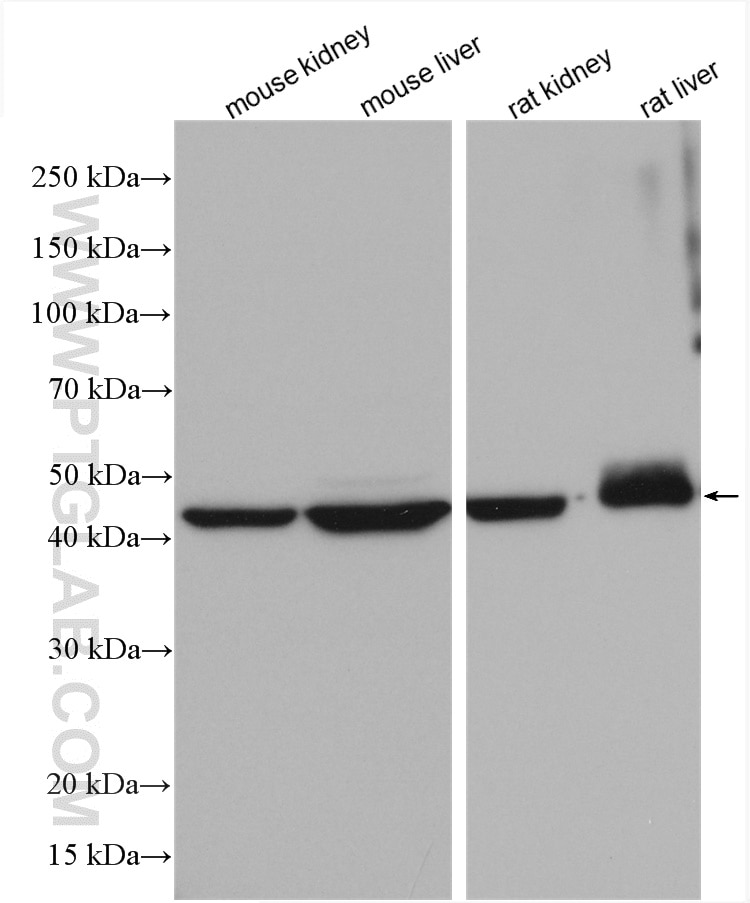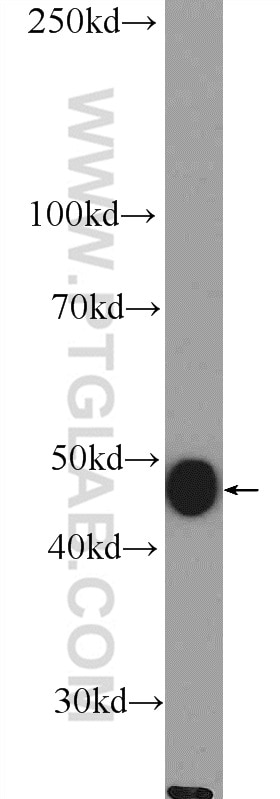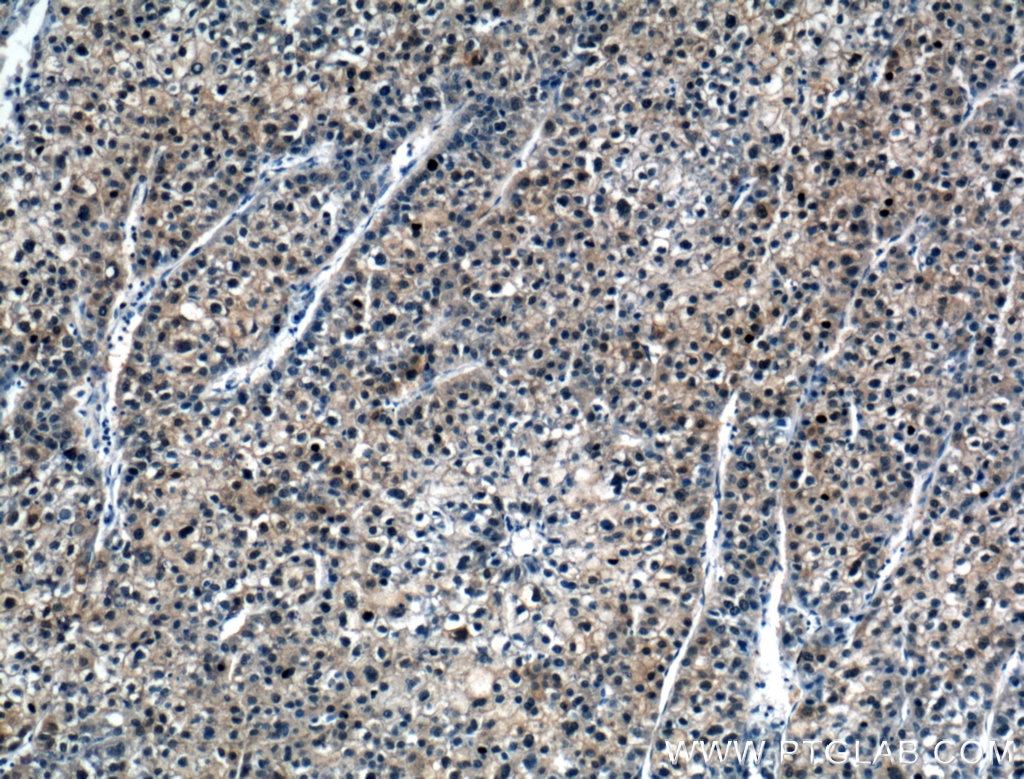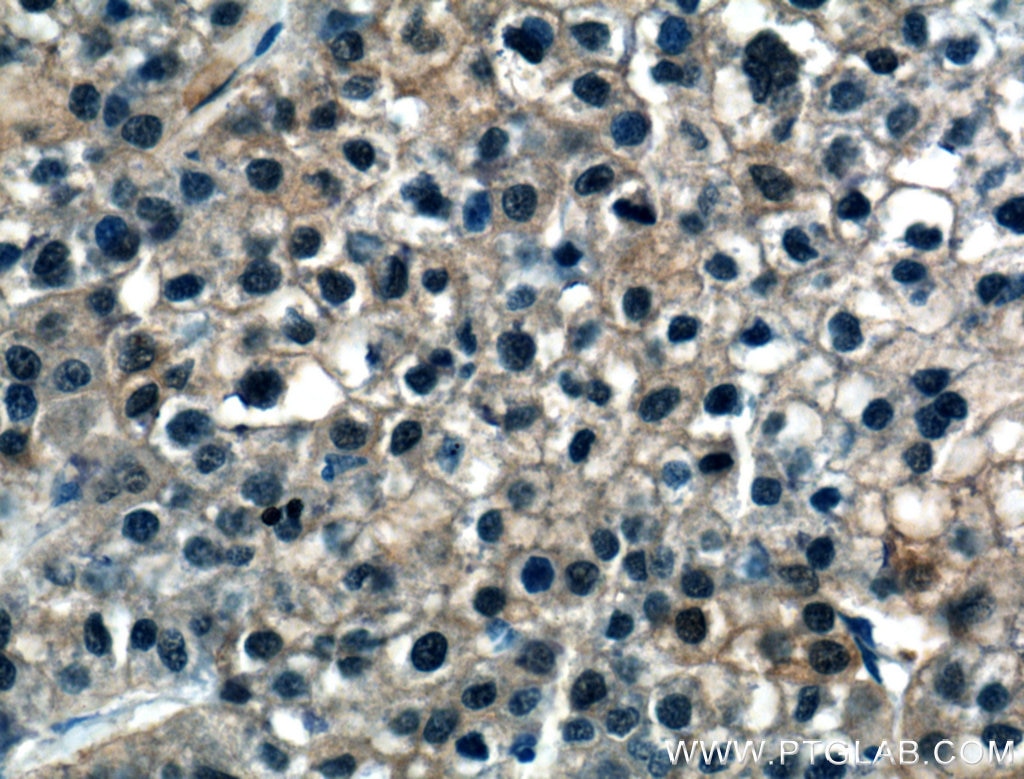ASL Polyklonaler Antikörper
ASL Polyklonal Antikörper für WB, IHC, ELISA
Wirt / Isotyp
Kaninchen / IgG
Getestete Reaktivität
human, Maus, Ratte
Anwendung
WB, IHC, ELISA
Konjugation
Unkonjugiert
Kat-Nr. : 16645-1-AP
Synonyme
Geprüfte Anwendungen
| Erfolgreiche Detektion in WB | Mausnierengewebe, Mauslebergewebe, Rattennierengewebe, Rattenlebergewebe |
| Erfolgreiche Detektion in IHC | humanes Leberkarzinomgewebe Hinweis: Antigendemaskierung mit TE-Puffer pH 9,0 empfohlen. (*) Wahlweise kann die Antigendemaskierung auch mit Citratpuffer pH 6,0 erfolgen. |
Empfohlene Verdünnung
| Anwendung | Verdünnung |
|---|---|
| Western Blot (WB) | WB : 1:1000-1:6000 |
| Immunhistochemie (IHC) | IHC : 1:100-1:400 |
| It is recommended that this reagent should be titrated in each testing system to obtain optimal results. | |
| Sample-dependent, check data in validation data gallery | |
Veröffentlichte Anwendungen
| WB | See 7 publications below |
| IHC | See 1 publications below |
Produktinformation
16645-1-AP bindet in WB, IHC, ELISA ASL und zeigt Reaktivität mit human, Maus, Ratten
| Getestete Reaktivität | human, Maus, Ratte |
| In Publikationen genannte Reaktivität | human, Maus |
| Wirt / Isotyp | Kaninchen / IgG |
| Klonalität | Polyklonal |
| Typ | Antikörper |
| Immunogen | ASL fusion protein Ag10007 |
| Vollständiger Name | argininosuccinate lyase |
| Berechnetes Molekulargewicht | 55 kDa |
| Beobachtetes Molekulargewicht | 49 kDa |
| GenBank-Zugangsnummer | BC008195 |
| Gene symbol | ASL |
| Gene ID (NCBI) | 435 |
| Konjugation | Unkonjugiert |
| Form | Liquid |
| Reinigungsmethode | Antigen-Affinitätsreinigung |
| Lagerungspuffer | PBS with 0.02% sodium azide and 50% glycerol |
| Lagerungsbedingungen | Bei -20°C lagern. Nach dem Versand ein Jahr lang stabil Aliquotieren ist bei -20oC Lagerung nicht notwendig. 20ul Größen enthalten 0,1% BSA. |
Hintergrundinformationen
Argininosuccinate lyase (ASL), one of the significant UC enzymes, catalyzes argininosuccinate cleavage to generate arginine and fumarate. Arginine is then catalyzed by arginase to ornithine and polyamines, which are found to promote cancer cell proliferation and growth. Importantly, ASL ectopic expression is closely associated with poor prognosis of colorectal cancer, hepatocellular. ASL is a member of the aspartase/fumarase superfamily. Enzymes of this superfamily share similar tetrameric structure and active site, though the sequence identities between different members are quite low (less than 20%). Members of this superfamily have been recognised as drug targets for microbial infections. ASL is a 464-amino-acid enzyme with a molecular mass of 49.7 kDa. (PMID: 22386318 PMID: 31018905)
Protokolle
| PRODUKTSPEZIFISCHE PROTOKOLLE | |
|---|---|
| WB protocol for ASL antibody 16645-1-AP | Protokoll herunterladen |
| IHC protocol for ASL antibody 16645-1-AP | Protokoll herunterladenl |
| STANDARD-PROTOKOLLE | |
|---|---|
| Klicken Sie hier, um unsere Standardprotokolle anzuzeigen |
Publikationen
| Species | Application | Title |
|---|---|---|
Cell Metab Lighting up arginine metabolism reveals its functional diversity in physiology and pathology | ||
Mol Metab SWI/SNF complex subunit BAF60a represses hepatic ureagenesis through a crosstalk between YB-1 and PGC-1α. | ||
Cell Discov TET2 is required to suppress mTORC1 signaling through urea cycle with therapeutic potential | ||
Sci Transl Med Aberrant methylmalonylation underlies methylmalonic acidemia and is attenuated by an engineered sirtuin | ||
ACS Nano Microneedles Loaded with Nitric-Oxide Driven Nanomotors Improve Force-Induced Efferocytosis Impairment and Sterile Inflammation by Revitalizing Macrophage Energy Metabolism | ||
Phytomedicine Crataegus pinnatifida polysaccharide alleviates DSS-induced colitis in mice by regulating the intestinal microbiota and enhancing arginine biosynthesis |





